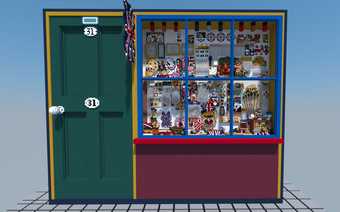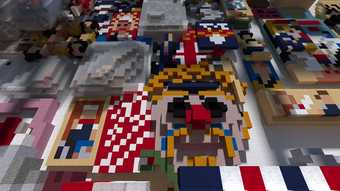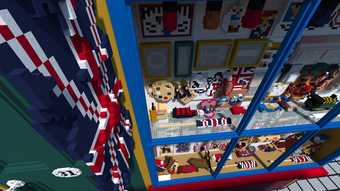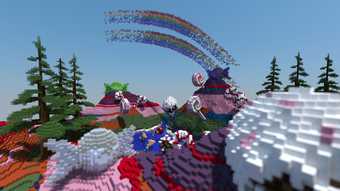In this Tate Worlds adventure, players drink a shrinking potion before being transported inside the shop window. On finding themselves toy sized, they are free to explore the many nooks and crannies stuffed full of objects from Peter Blake’s collection. Meeting exciting characters along the way, players dress as superheroes and fire arrows at targets, but they must be careful not to get caught by any of the scarier toys. Using a grappling hook to scale the shelves, they search for objects, complete challenges and collect the activity badges needed to complete the game.
To guide players on their journey, Minecraft explorer cat Stampylongnose has some useful tales to tell. Find the old-fashioned records scattered around the toy shop and place them in the jukebox to hear Stampy’s words of wisdom. Collect all twelve records to receive the final ‘disc jockey’ badge.
Tate Worlds: The Toy Shop can be played in both singleplayer and multiplayer mode (maximum 8 players in up to 4 teams). You must have Minecraft version 1.8.3 to play this map. In multiplayer mode, the first team to complete each challenge and collect all the activity badges, placing them in the correct places, wins the game.
Ask your mum, dad or guardian for permission before playing multiplayer games online.
Only play Minecraft maps online with people you know and trust (such as your friends from school).
We recommend that all players under the age of 18 consult a parent or guardian before attempting to access an online multiplayer server or network. For information on how to stay safe online, younger players may find this safety guide useful, or visit our FAQs page for more information, including how to download and install Tate Worlds maps.
- Download the Single/Multi-player instructions for this map, including recommended sound and video settings [PDF, 422 Kb]
Watch the video explaining Multiplayer mode
This film file is broken and is being removed. Sorry for any inconvenience this causes.
Tate Worlds: The Toy Shop – Multiplayer Guidelines
- Download the texture pack for the map separately (for players wanting to access an external multiplayer server already hosting the map)
To copy and paste the code mentioned in the video, download this Single/Multiplayer instructions PDF and copy the code from page three.
The artwork that inspired the game
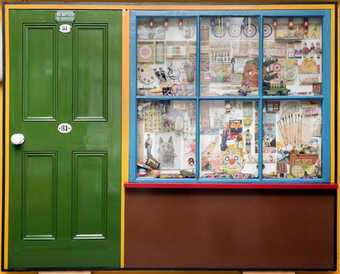
Peter Blake
The Toy Shop (1962)
Tate
Peter Blake’s art reflects his affection and nostalgia for the popular culture of his own childhood and youth, his favourite sources including toys, comics, badges, pop music and jazz, Hollywood films and film stars, fairgrounds, and other popular entertainments such as all-in wrestling and striptease.
The toys in this work are from Blake’s own collection of such things and it was partly conceived as a solution to the problem of how to store safely some of the smallest items. The choice of these is so personal, the artist has said, that the work amounts to a kind of self-portrait, reflecting his interests and activities.
Examination reveals, among much else, obvious references to painting in the toy palettes, card of brushes and child’s paint box, and to pop music in the picture postcards of Elvis Presley, Chubby Checker and others. There are also references to other art notably in the Whirlpool and Slipperyslabs puzzles in the upper left window. These were certainly chosen for their evocation of, respectively, the target paintings of the American abstract painter Kenneth Noland and the grid-like abstract paintings of Mondrian, representing a kind of art to which Pop was theoretically opposed, although in fact strong abstract elements are often present in it - the grid of the windows here, for example. The fairground targets, which are also prominent, refer to Blake’s love of the fair and probably to the target paintings, seen as precursors of Pop Art, of the American Jasper Johns.
Blake’s overall aim in this work is to evoke an old fashioned corner shop with a window full of cheap toys, which he does so effectively that at first glance it might be the real thing, perhaps taken from a demolition site and reconstructed in the museum. However, the colours of the window and its surround are the three primaries red, yellow and blue. These are an unlikely choice for a real shop front but here they seem natural and appropriate because they echo the heraldic colours of the union flags and targets in the window, as well as the flag Blake attached to the outside. The door is a convincing green and appears highly realistic in construction until the spectator becomes aware of its less than human scale, giving the work a slightly mysterious, Alice-in-Wonderland quality.
Published in
Simon Wilson, Tate Gallery: An Illustrated Companion, Tate Gallery, London, revised edition 1991, p.239

